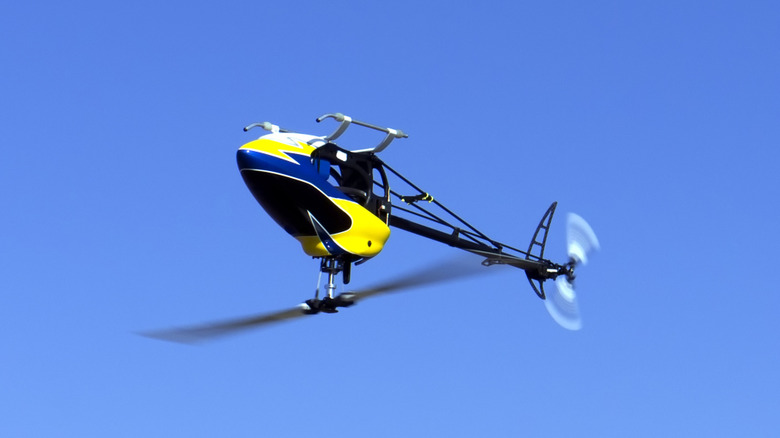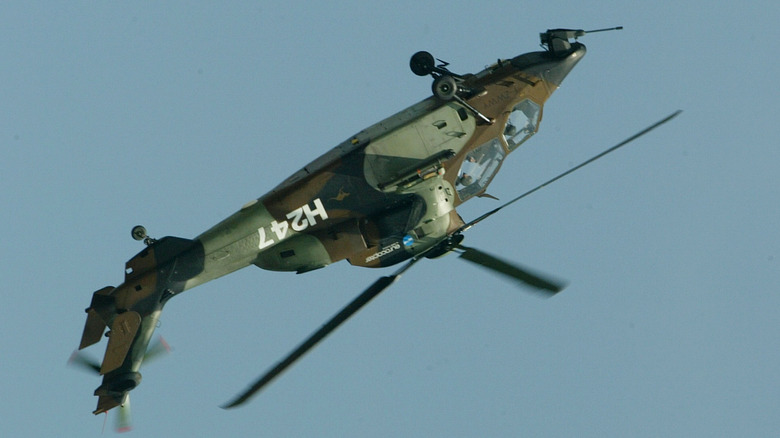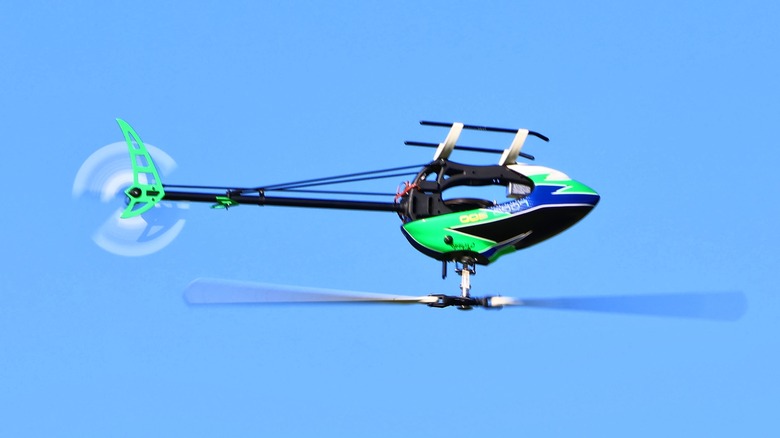Here's Why RC Helicopters Can Fly Upside Down (And Why Real Ones Don't)
In 2019, a modified BO-105 helicopter with Red Bull branding — of course — flew over New York City. It performed barrel rolls, flips, and nosedives against the Statue of Liberty's backdrop. An average helicopter pilot can't handle those tricks. On the other hand, a much smaller remote-controlled helicopter can pull off all those stunts, and then some more. Why?
According to a paper presented at the Experimental Robotics IX conference (PDF), RC helicopters can fly inverted because they can easily adjust the pitch angle, allowing the rotor to produce negative thrust that keeps them flying. Since they are lighter, the load exerted on the joint connecting the rotor blades with the fuselage is much lower. And due to the relatively small size of the blade, there is little concern about bends and flops.
On an average passenger helicopter, the main rotor — not the tail rotor at the back — and the joints are not designed to bear the weight of an upside-down helicopter. Second, the engine and fuel kit can't operate in a position where the fuel tanker and other liquid components can operate against gravity. Moreover, you will need specialized controls that can tilt the rotor downwards so that it can still generate lift. If the rotors are flexible and the helicopter goes upside down, there's a chance it crashes against the main body, leading to serious damage and endangering the safety of passengers aboard. And even when helicopters can briefly fly inverted while doing a barrel roll, they must do it at a sufficiently high altitude and forward momentum.
The big challenges
One of the biggest challenges with sustained vertical flight is the fuel system. Helicopters predominantly rely on an engine that burns aviation-grade fuel to produce energy. The fuel, you see, is in a liquid state, contained in a tanker with a pipe feeding it. If the helicopter inverts (and so does the engine), the supply will be cut off because the fuel is now settled at the bottom, and the feeding pipe at the top is left empty.
In a nutshell, the engine will be deprived of fuel, and the power supply will be cut off mid-way through the flight if the helicopter is flying belly up. Long story short, the vehicle will come crashing down. To tackle the challenge of fighter jets, which perform aerial stunts like inverted flight or angled flights, engineers created specialized fuel systems that ensure a constant supply of fuel to the cylinders irrespective of the plane's spatial orientation.
You will also need to be an expert of very high caliber in order to fly a helicopter upside down, that is, assuming one such vehicle is technically developed. Just how skilled? Well, the Red Bull helicopter that was performing aerial acrobatics over the Hudson River was Aaron Fitzgerald, a former paratrooper in the U.S. Army's 82nd Airborne Division, Medal of Valor recipient, and a member of Red Bull's The Flying Bulls Team. Who also worked on over hundreds of films and TV shows with thousands of hours worth of flight time under his belt.
The feasibility question
Technically, inverted flight is possible, but only for a brief spell and not a sustained hover. How did Red Bull manage it? The stunt helicopter piloted by Fitzgerald is equipped with a titanium rotor. "It allows Fitzgerald to reverse the airflow through the rotor without damaging anything, ensuring he can safely execute the manoeuvres," the company explains. The twin-engine helicopter comes with a hinge-less rotor design that allows it to execute stomach-churning maneuvers in the air.
The secret sauce is the rotor head, which is made from a single block of titanium metal instead of a component assembly held together by weldings, nuts, and bolts. The design allows the blades to avoid bouncing and also eliminates vertical blade movement, offering higher precision with flight controls. Fitzgerald told WIRED that the fixed rotor allows the helicopter to generate thrust in any position, and coupled with the minimal rotor movement, he can recover the helicopter from the aerial stunts and bring it back to stable flight.
And let's not forget that the customization job required to make a single-block fixed rotor assembly made from titanium would be quite expensive. Moreover, the passengers would get a serious case of motion sickness. Likewise, specialized fuel systems that allow fighter jets to execute inverted flight maneuvers during a dog fight don't come cheap. To put that into perspective, the U.S. government is currently struggling to bring the price of fighter jets down to the $80-100 million range. You can buy a Bell helicopter for a fraction of that price.


